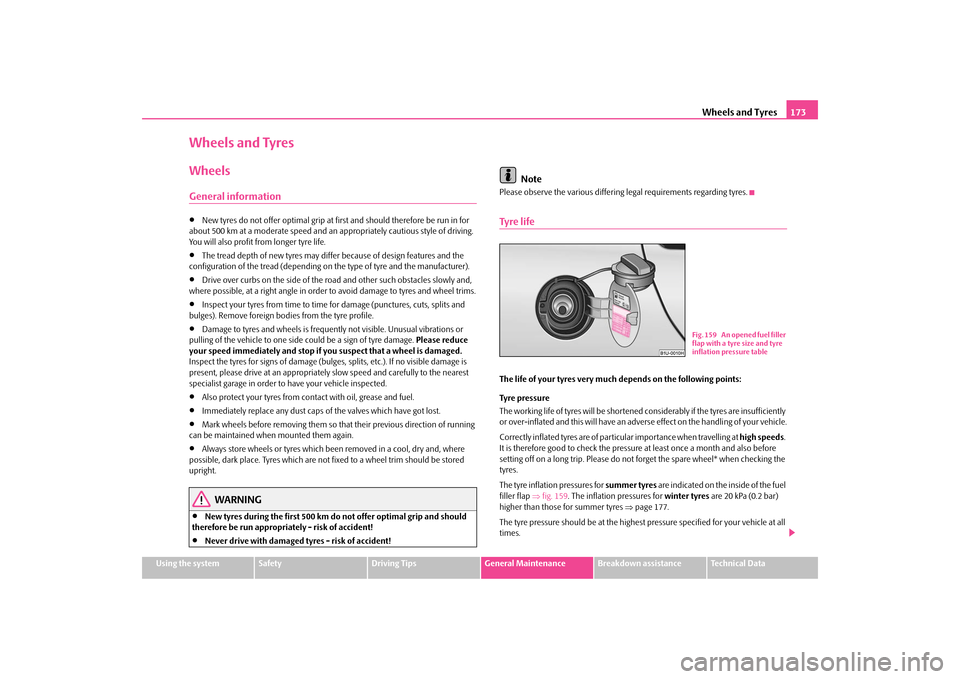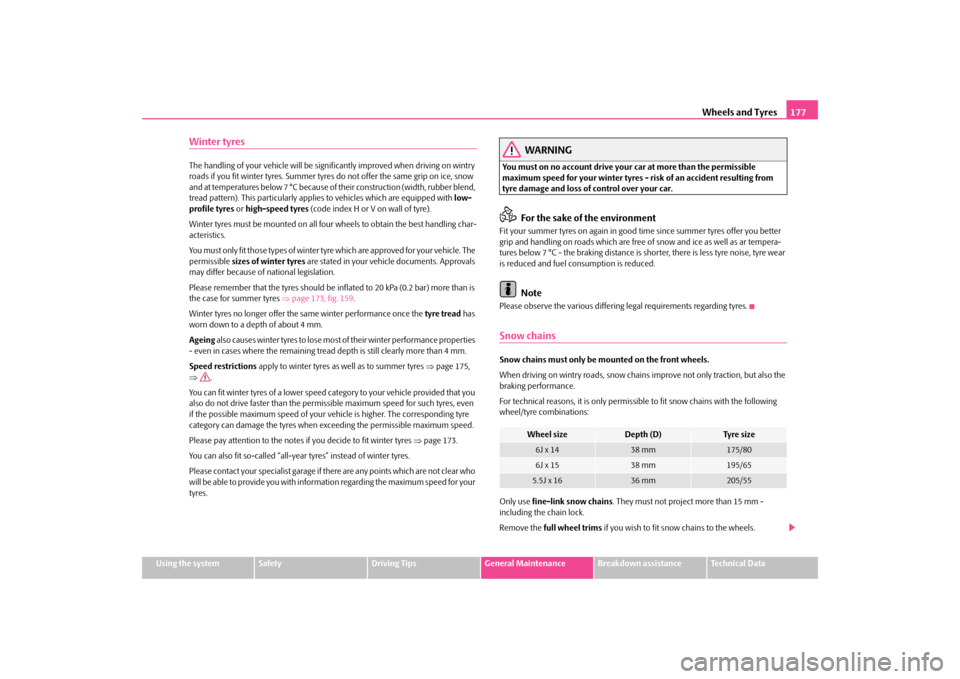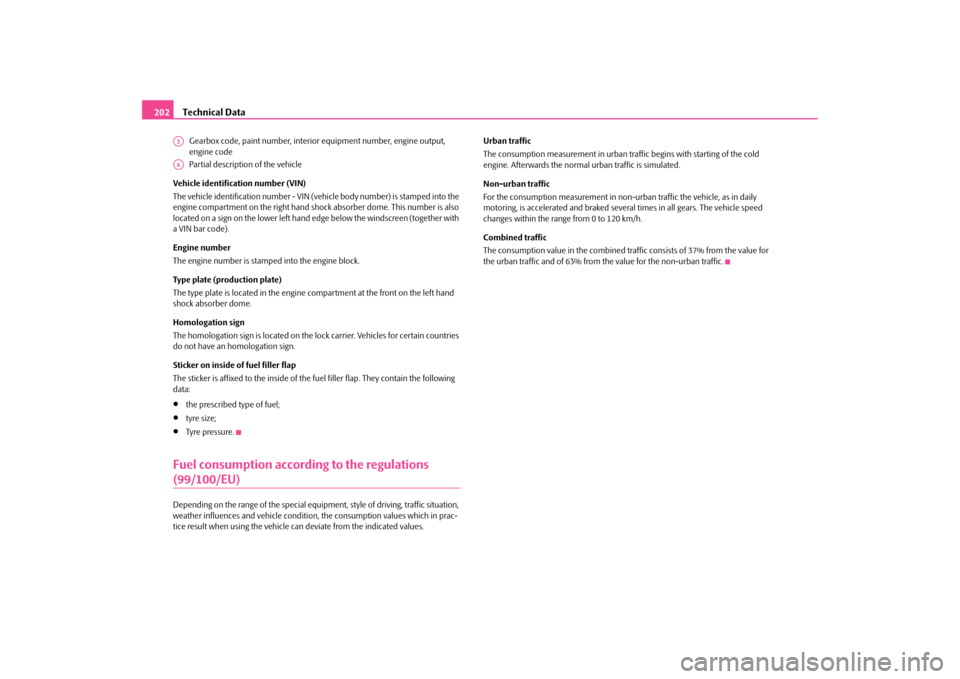fuel type SKODA OCTAVIA TOUR 2009 1.G / (1U) Owner's Manual
[x] Cancel search | Manufacturer: SKODA, Model Year: 2009, Model line: OCTAVIA TOUR, Model: SKODA OCTAVIA TOUR 2009 1.G / (1U)Pages: 224, PDF Size: 13.53 MB
Page 174 of 224

Wheels and Tyres
173
Using the system
Safety
Driving Tips
General Maintenance
Breakdown assistance
Technical Data
Wheels and TyresWheelsGeneral information•
New tyres do not offer optimal grip at first and should therefore be run in for
about 500 km at a moderate speed and an
appropriately cautious style of driving.
You will also profit from longer tyre life.•
The tread depth of new tyres may differ
because of design features and the
configuration of the tread (depending on
the type of tyre and the manufacturer).
•
Drive over curbs on the side of the road
and other such obstacles slowly and,
where possible, at a right angle in order to avoid damage to tyres and wheel trims.•
Inspect your tyres from time to time
for damage (punctures, cuts, splits and
bulges). Remove foreign bodies from the tyre profile.•
Damage to tyres and wheels is frequent
ly not visible. Unus
ual vibrations or
pulling of the vehicle to one side
could be a sign of tyre damage.
Please reduce
your speed immediately and stop if
you suspect that a wheel is damaged.
Inspect the tyres for signs of damage (bulges,
splits, etc.). If no
visible damage is
present, please drive at an appropriatel
y slow speed and carefully to the nearest
specialist garage in order to have your vehicle inspected.•
Also protect your tyres from contact with oil, grease and fuel.
•
Immediately replace any dust caps of the valves which have got lost.
•
Mark wheels before removing them so th
at their previous direction of running
can be maintained when mounted them again.•
Always store wheels or tyres which been removed in a cool, dry and, where
possible, dark place. Tyres which are not fixed to a wheel trim should be stored upright.
WARNING
•
New tyres during the first 500 km do not offer optimal grip and should
therefore be run appropriately - risk of accident!•
Never drive with damaged tyres - risk of accident!
Note
Please observe the various differing legal requirements regarding tyres.Tyre lifeThe life of your tyres very much depends on the following points: Tyre pressure The working life of tyres will be shortened considerably if the tyres are insufficiently or over-inflated and this will have an advers
e effect on the handli
ng of your vehicle.
Correctly inflated tyres are of partic
ular importance when travelling at
high speeds
.
It is therefore good to check the pressure at least once a month and also before setting off on a long trip. Please do not
forget the spare wheel* when checking the
tyres. The tyre inflation pressures for
summer tyres
are indicated on the inside of the fuel
filler flap
⇒fig. 159
. The inflation pressures for
winter tyres
are 20 kPa (0.2 bar)
higher than those for summer tyres
⇒page 177.
The tyre pressure should be at the highest
pressure specified for your vehicle at all
times.
Fig. 159 An opened fuel filler flap with a tyre size and tyre inflation pressure table
s2g8.b.book Page 173 Tuesday, April 7, 2009 8:53 AM
Page 178 of 224

Wheels and Tyres
177
Using the system
Safety
Driving Tips
General Maintenance
Breakdown assistance
Technical Data
Winter tyresThe handling of your vehicle will be significantly improved when driving on wintry roads if you fit winter tyres. Summer tyres do not offer the same grip on ice, snow and at temperatures below 7 °C because of
their construction (width, rubber blend,
tread pattern). This partic
ularly applies to vehicles
which are equipped with
low-
profile tyres
or high-speed tyres
(code index H or V on wall of tyre).
Winter tyres must be mounted on all four wheels to obtain the best handling char- acteristics. You must only fit those types of winter tyre which are approved for your vehicle. The permissible
sizes of winter tyres
are stated in your vehicle documents. Approvals
may differ because of national legislation. Please remember that the tyres should be in
flated to 20 kPa (0.2 bar) more than is
the case for summer tyres
⇒page 173, fig. 159
.
Winter tyres no longer
offer the same winter performance once the
tyre tread
has
worn down to a depth of about 4 mm. Ageing
also causes winter tyres to lose most of their winter performance properties
- even in cases where the remaining tread depth is still clearly more than 4 mm. Speed restrictions
apply to winter tyres as well as to summer tyres
⇒page 175,
⇒
.
You can fit winter tyres of a lower speed ca
tegory to your vehicle provided that you
also do not drive faster than the permis
sible maximum speed fo
r such tyres, even
if the possible maximum speed of your ve
hicle is higher. The corresponding tyre
category can damage the tyres when ex
ceeding the permissi
ble maximum speed.
Please pay attention to the notes if
you decide to fit winter tyres
⇒page 173.
You can also fit so-called “all-year tyres” instead of winter tyres.Please contact your specialist garage if
there are any points which are not clear who
will be able to provide you with information regarding the maximum speed for your tyres.
WARNING
You must on no account drive your car at more than the permissible maximum speed for your winter tyres - risk of an accident resulting from tyre damage and loss of control over your car.
For the sake of the environment
Fit your summer tyres on again in good ti
me since summer tyres offer you better
grip and handling on roads which are free of snow and ice as well as ar tempera-tures below 7 °C - the braking distance is shorter, there is less tyre noise, tyre wear is reduced and fuel consumption is reduced.
Note
Please observe the various differing legal requirements regarding tyres.Snow chainsSnow chains must only be mounted on the front wheels. When driving on wintry roads, snow chains
improve not only traction, but also the
braking performance. For technical reasons, it is only permissi
ble to fit snow chains with the following
wheel/tyre combinations: Only use
fine-link snow chains
. They must not project more than 15 mm -
including the chain lock. Remove the
full wheel trims
if you wish to fit snow
chains to the wheels.
Wheel size
Depth (D)
Ty re s i z e
6J x 14
38 mm
175/80
6J x 15
38 mm
195/65
5.5J x 16
36 mm
205/55
s2g8.b.book Page 177 Tuesday, April 7, 2009 8:53 AM
Page 203 of 224

Technical Data
202
Gearbox code, paint number, interior
equipment number, engine output,
engine code Partial description of the vehicle
Vehicle identification number (VIN) The vehicle identification num
ber - VIN (vehicle body number) is stamped into the
engine compartment on the right hand shoc
k absorber dome. This number is also
located on a sign on the lower left hand
edge below the windscreen (together with
a VIN bar code). Engine number The engine number is stamped into the engine block. Type plate (production plate) The type plate is located in the engine co
mpartment at the front on the left hand
shock absorber dome. Homologation sign The homologation sign is located on the lo
ck carrier. Vehicles for certain countries
do not have an homologation sign. Sticker on inside of fuel filler flap The sticker is affixed to the inside of the fuel filler flap. They contain the following data:•
the prescribed type of fuel;
•
tyre size;
•
Tyre pressure.
Fuel consumption according to the regulations (99/100/EU)Depending on the range of the special equipment, style of driving, traffic situation, weather influences an
d vehicle condition, the consum
ption values which in prac-
tice result when using the vehicle ca
n deviate from the indicated values.
Urban traffic The consumption measurement in urban traf
fic begins with starting of the cold
engine. Afterwards the normal
urban traffic is simulated.
Non-urban traffic For the consumption measurement in non-ur
ban traffic the vehicle, as in daily
motoring, is accelerated and braked several times in all gears. The vehicle speed changes within the range from 0 to 120 km/h. Combined traffic The consumption value in the combined traf
fic consists of 37%
from the value for
the urban traffic and of 63% from
the value for the non-urban traffic.
A3A4s2g8.b.book Page 202 Tuesday, April 7, 2009 8:53 AM